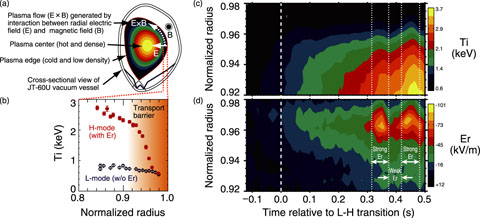
Fig.3-15 Cross-sectional view of plasma (a), an ion temperature profile (b), a contour plot of spatiotemporal structures of ion temperature Ti (c), and radial electric field Er (d)
With an economically attractive fusion reactor, a high fusion output should be achieved. Since the fusion output is proportional to the square of the plasma pressure (= temperature × density), various operational regimes with the plasma pressure as high as possible have been developed. The high-confinement-mode (H-mode) operation involving the edge pedestal structure (thermal barrier) is nominated as a standard operational scenario for the International Thermonuclear Experimental Reactor (ITER), as shown in Fig.3-15 (left bottom). In the H-mode, the plasma pressure increases by a factor of two (it is to be noted that the fusion output increases by a factor of four) relative to the plasma pressure in the case of plasma confinement without any pedestal (L-mode). At the transition from the L-mode to the H-mode (L-H transition), it is believed that a spontaneously generated radial electric field (Er) in the localized region just inside the plasma boundary strongly influences the essential condition for improved confinement to exist. The theory suggests that the E × B shear flow suppresses edge turbulence and that the suppression in turn inhibits transport, thus enabling pedestal formation, although the edge evolution in Er and its connection to H-mode confinement are not well understood.
In the JT-60U tokamak, we performed an improved confinement experiment in the presence of a strong magnetic field that was similar to the magnetic field in the ITER, and we determined the spatiotemporal structures of the radial electric field by means of spectroscopy with high spatial and temporal resolution. As shown in Fig.3-15, the Er profile (right bottom) was found to develop at and after the transition to the H-mode, indicating the formation of an edge “well” structure, and the steepening of the Ti profile (right top) was accelerated as expected in the case of the standard model. The most obvious concomitant feature was a rapid drop in the edge Er value at the instant when the time relative to the L-H transition was ∼0.315 s, particularly at a normalized radius of ∼0.96, indicating a strong deepening (approximately by a factor of two) of the Er well structure. A clear bifurcation of the edge Er trend into weakly negative and strongly negative trends was observed in the later H-mode phase. Both trends showed essentially the same confinement properties despite corresponding to two very different Er structures. The results indicate that energy confinement improvement may not necessarily be connected to the E × B shear flow suppression of turbulence. These results are unexpected in the case of the standard theory, and are world leading results.